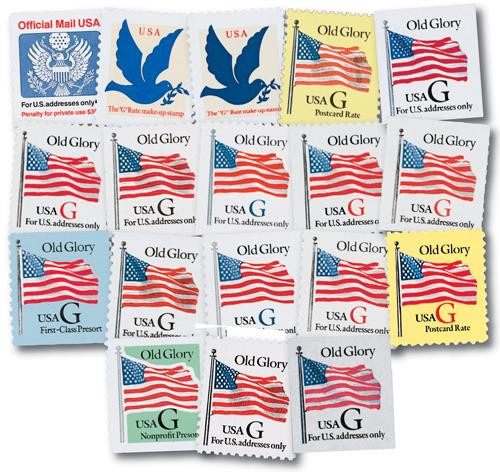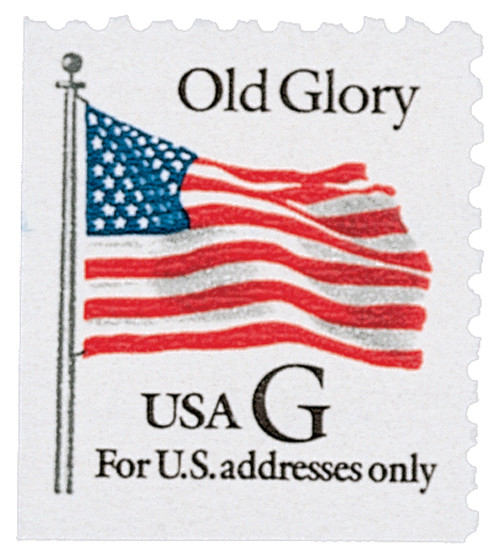
# 2893 - 1995 5c G-rate Old Glory, Non-profit
U.S. #2893
1994 G-rate Old Glory
- Issued as a non-denominated stamp
Stamp Category: Definitive
Set: G Series
Value: 5¢ Non-profit Rate
First Day of Issue: January 12, 1995
First Day City(s): Washington, DC
Quantity Issued: 780,800,000
Printed by: American Bank Note Company
Printing Method: Gravure Printing
Format: Coils of 500 and 3,000
Perforations: 9.8
Why the stamp was issued: The USPS issued this G series general-use stamp for the new first-class rate that took place in 1995.
About the stamp design: This stamp was designed by Ronald Sharpe who was the first African-American Banknote Designer at the Bureau of Engraving and Printing. The blue “G” on the front of the stamp is an obvious indication that it was printed by American Bank Note Company.
Special design details: The USPS had a few other design ideas that would match the G rate stamp such as a goose, grapes and even George Washington, but they settled on “Old Glory.”
About the printing process: Guilford Gravure Division of George Schmitt and Company printed these stamps for American Bank Note Company on a 5-color Andreotti webfed gravure press.
First Day City: Most definitive stamps that don’t receive a first day ceremony get issued in Washington, DC which is home of the United States Postal Headquarters.
About the G-rate Series: The USPS issued G-rate stamps to aid in the transition of a new postal rate. All, except two, G-rate stamps picture the US Flag with “Old Glory” in text above it, the other two are blue doves. They released eighteen different versions of G-rate stamps. These came in six different formats, in five varied rates, from five different printers! These include six different sheet stamps, six coils, four booklets, and two self-adhesives. This made the G-rate stamps printed by more printers and in more formats that any previous rate change stamp.
History the stamp represents: The US Postal Service started making rate change stamps, or “contingency” stamps as they were known, in 1978 with the A-rate which was fifteen cents. They wanted to make sure they had stamps to fulfill any rate change, gap in prices, or any combination. In early 1981 the B-rate stamps were issued to make up eighteen cents. At the end of 1981 the C-rate for twenty cents was issued. A few years went by before the D-rate came along in 1985. With the E-rate collectors saw a shift from an eagle with the color stamp to the image reflecting the letter, E having an Earth on the stamp in 1988. The F make-up-rate was only four cents and depicted a tulip on the stamp. G-rate was in 1995 and H followed in 1999. Collectors thought they were going to keep going following the rest of the alphabet, but H was where it ended. Many joked that the US Postal Service didn’t want to issue an I-rate stamp, but the reasons behind the end was never clear.
U.S. #2893
1994 G-rate Old Glory
- Issued as a non-denominated stamp
Stamp Category: Definitive
Set: G Series
Value: 5¢ Non-profit Rate
First Day of Issue: January 12, 1995
First Day City(s): Washington, DC
Quantity Issued: 780,800,000
Printed by: American Bank Note Company
Printing Method: Gravure Printing
Format: Coils of 500 and 3,000
Perforations: 9.8
Why the stamp was issued: The USPS issued this G series general-use stamp for the new first-class rate that took place in 1995.
About the stamp design: This stamp was designed by Ronald Sharpe who was the first African-American Banknote Designer at the Bureau of Engraving and Printing. The blue “G” on the front of the stamp is an obvious indication that it was printed by American Bank Note Company.
Special design details: The USPS had a few other design ideas that would match the G rate stamp such as a goose, grapes and even George Washington, but they settled on “Old Glory.”
About the printing process: Guilford Gravure Division of George Schmitt and Company printed these stamps for American Bank Note Company on a 5-color Andreotti webfed gravure press.
First Day City: Most definitive stamps that don’t receive a first day ceremony get issued in Washington, DC which is home of the United States Postal Headquarters.
About the G-rate Series: The USPS issued G-rate stamps to aid in the transition of a new postal rate. All, except two, G-rate stamps picture the US Flag with “Old Glory” in text above it, the other two are blue doves. They released eighteen different versions of G-rate stamps. These came in six different formats, in five varied rates, from five different printers! These include six different sheet stamps, six coils, four booklets, and two self-adhesives. This made the G-rate stamps printed by more printers and in more formats that any previous rate change stamp.
History the stamp represents: The US Postal Service started making rate change stamps, or “contingency” stamps as they were known, in 1978 with the A-rate which was fifteen cents. They wanted to make sure they had stamps to fulfill any rate change, gap in prices, or any combination. In early 1981 the B-rate stamps were issued to make up eighteen cents. At the end of 1981 the C-rate for twenty cents was issued. A few years went by before the D-rate came along in 1985. With the E-rate collectors saw a shift from an eagle with the color stamp to the image reflecting the letter, E having an Earth on the stamp in 1988. The F make-up-rate was only four cents and depicted a tulip on the stamp. G-rate was in 1995 and H followed in 1999. Collectors thought they were going to keep going following the rest of the alphabet, but H was where it ended. Many joked that the US Postal Service didn’t want to issue an I-rate stamp, but the reasons behind the end was never clear.





















